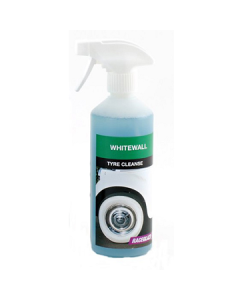Cleaning Whitewall Tyres
Maintaining White Wall or White Letter Tyres
Whitewall or raised white letters tyres will need continual maintenance; they are not a fit and forget item. You will need to keep the tyres clean, usually just with hot soapy water.
NEVER USE tyre shine products on Whitewall or RWL letters, many of these products have enhancers for black tyres that will discolour the white rubber permanently.
Tyre Blooming
Tyre manufacturers are continuously developing the design of tyres to meet the demands of today's automobiles and drivers. People now expect higher mileage, more miles per gallon, superior all-weather traction, higher speed, and better road holding as cars become faster and more advanced. We need better performance from our automobiles, and tyres are a vital part of that. However, we seldom take the time to understand what has changed about tyres other than the transition from crossply to radial ply in the late 1960s.
We've had E marks and ECE regulation over the years, then came tyre labelling to know the noise level, fuel economy, and wet weather braking, and there are also expectations on tyre manufactures to not harm the environment and to ban components that used to be used due to their carcinogenic properties and environmental impact. A few years ago, legislation was changed to make it illegal to sell tyres that did not meet PAH standards. PAH necessitated manufacturers to remove hazardous oils, and since that time we have experienced a tyre bloom problem.
For further details, search the web for "my tyres are becoming brown." Black tyres can also become brown. It is often suggested to use a tyre shine to prevent this, however it cannot be used on a whitewall tyre since it would cause the white part of your tyre to turn brown even faster. A whitewall tyre should avoid any tyre shine product.
Unfortunately, all kinds of tyres now require a higher level of cleaning, and tyre blooming can affect even a car parked inside. We do offer a whitewall product that is advertised alongside all of the whitewall tyres. Additionally, all narrow band whitewalls and RWL tyres, including BFG, have a whitewall veneer, only the wide whitewalls have a white rubber sidewall.
Anti-Ozonant
You may not have heard of an anti-ozonant before. It is an organic substance applied to rubber that prevents or delays the degradation caused by exposure to the elements. Anti-ozonants are often used as an additive in virtually all outer rubber and plastic parts, but they are most commonly used in tyre manufacture.
The anti-ozonant ingredient slows the drying, brittleness, oxidation, and cracking of plastics and rubbers. It does this by preventing the material's surface from oxidising and keeping the substance flexible.
We have high mileage tyres, performance tyres, and everything in between due to anti-ozonants in rubber compositions. Without anti-ozonants, sports vehicles would shred tyres at breakneck speeds. Even your everyday commuting vehicle would require tyre replacements significantly more frequently as the sun and heat gradually wore away the rubber compounds. Tyre rubber formulations are developed in such a way that the anti-ozonant is always being pushed to the outside of the tyre, keeping the outside surface and sidewall flexible and resistant to oxidation.
Anti-ozonant oxidises when it reaches the exterior of the tyre and is exposed to air and moisture, resulting in a brownish residue. This is known as tyre blooming. Making matters worse, mould releases are used in manufacturing procedures. These lubricant-type substances make the interior of a tyre mould non-stick. The mould forms chemical connections with the tyre and attaches anti-ozonants to the tyre's surface.
While some may blame mould release as the major and/or sole cause of tyre blooming, this is usually only a portion of the problem. Even after the mould release has been removed, the tyre will continue to push anti-ozonant to the surface, causing the brown residue to resurface.


